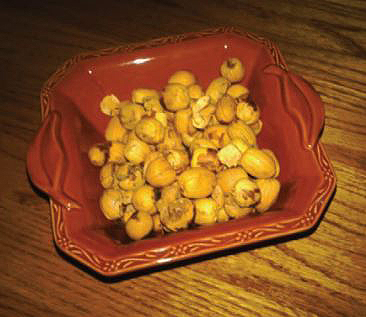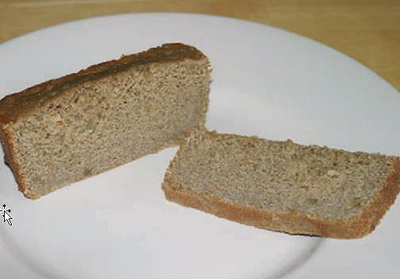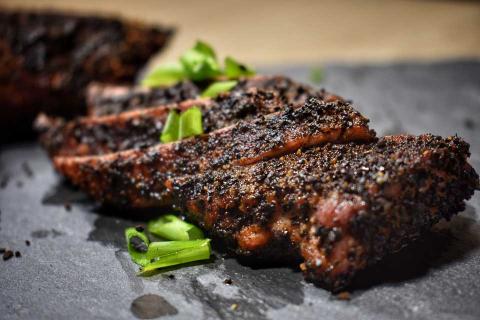Originally published in GameKeepers: Farming for Wildlife Magazine
Jeff Foxworthy is a very funny man, and a few years ago he delivered a very funny keynote address at the Quality Deer Management Convention. He spoke about his lifelong love of deer, and how he admires QDMA experts in the same way many folks admire Hollywood stars. Toward the end of his talk Foxworthy told a series of “You might be a quality deer manager” jokes along the lines of his famous “Redneck series” for which he is famous. I really liked this one: “If your deer have new bedding but your wife doesn’t, you might be a quality deer manager.” But this is the joke that really struck a chord with me: “If your deer eat better than your children do, you might be a quality deer manager.” Another laugh-out-loud line to be sure. But I doubt Foxworthy realized that his words were true in a sense; in one way deer really do eat better than people do, for this simple reason:
Deer eat acorns…we don’t. Acorns were once the “staff of life” for humankind. Humans have consumed more acorns than wheat, rice and corn combined. Acorns remained a dietary staple until very recently in parts of Europe (in parts of Spain and France acorns accounted for 20% of caloric intake until the late 19th century), parts of Asia (notably Korea), and California among the indigenous people. The naturalist John Muir called the dry acorn cakes eaten by the local native people, "the most compact and strength giving food" he had ever used. I might be romanticizing a bit here, but it is my belief that the healthiest, happiest and most peaceful people who have ever lived on Earth were acorn-eaters.
Why Did Humans Eat Acorns?

mortars were carved by the Chumash people in what is now Morro Bay State Park.
The answer is easy. Acorns are incredibly nutritious and easy to gather. Acorns are rich in protein, amino acids and carbohydrates, but most importantly fat. People once inherently understood that fat is an essential nutrient, back before dietary geniuses told us that fat is evil (and before we all got fat trying to avoid eating fat). Communities who subsisted largely on acorns could gather a year’s worth of nutrition in just a few days of work. In my research I have noticed that European regions that rely heavily on tree crops (these days it’s more likely walnuts and chestnuts than acorns) have an awful lot of leisure time on their hands. Bocce ball is huge among nut eating cultures, so is sitting in the shade, drinking coffee and chatting…for hours. I have also found a study from Korea suggesting that eating sawtooth oak (Quercus acutissima) acorns can delay the onset of dementia. You realize what this means, of course; with the widespread planting of sawtooth oak for wildlife habitat, our deer and wild turkeys have better memories than we do. Then again, some hunters already know that.
Why did we stop eating acorns? That answer is considerably more complicated. An acorn diet was truly “easy street” in terms of nutritional value per man hour expended. So why break our backs working the soil to produce annual grain crops instead? Two dueling groups of anthropologists (and trust me, there’s nothing more fierce and scary than a dueling anthropologists) have filled a lot of research papers trying to explain the transition from acorn to agriculture. One group claims that annual crop agriculture made permanent settlements – a.k.a. “civilization” – possible. The other group claims that permanent settlements over-taxed local acorn resources causing catastrophic food shortages that necessitated the development of annual crops.
Either way, it’s our great loss, both in terms of health and in terms of energy expended (both human and fuel) per calorie consumed. It’s time to rediscover the benefits of adding acorns to our diet.
Making Acorn Flour
If you eat acorns raw you will notice that after an initial sweet, nutty, sometimes buttery taste, your tongue will quickly start to go numb, as though you have been sucking on boot leather for an hour (I’m guessing here – I haven’t actually sucked on boot leather, and anyways it wasn’t for a whole hour). That’s the tannins you’re tasting – tannins which, coincidentally, are used in tanning leather. Luckily those tannins are water soluble and are easily removed.
Acorn flour is one of the more versatile acorn recipes, as it can be used for a wide range of foods, including acorn bread, pizza dough, cookies and pancakes. The following recipes would go great with any wild game dinner featuring the meat you’ve hunted yourself. Here is a simple acorn flour recipe, compiled with the help of Honest Food.

ready to be ground into meal and leached of tannins.
Research in Korea suggests that eating sawtooth oak
acorns can help delay the onset of dementia.
1. Gather acorns.
Acorns from the white oak group (bur oak, swamp chestnut oak, overcup oak, etc. – the ones with the rounded leaf tips) tend to be less tannic, but that’s a generalization. Try various types of acorns from various trees and you’ll notice enormous variation in sweetness between acorns of the same species, with some that can be eaten right off the tree and some that really curl your toes.
2. Shell the acorns.
The high-tech tools I use most often to do this: A hammer (pounding the top of the acorn where the cap used to be) and my teeth. Don’t tell my dentist.
3. Leach the tannins.
Grind the raw acorn nutmeats into fine meal – a coffee grinder works, or you can go “old school” with a mortar and pestle. Mix 1 cup of the meal for every 3 cups of cold water, and pour into a glass jar with a lid. Once each day shake the mixture, wait 12 hours, pour off the water (and dissolved tannins), and replace the water. Repeat for one to two weeks until the flour has lost its tannic bitterness.
4. Dry the flour.
Pour the acorn/water mixture into a cheesecloth strainer and gently squeeze out the water. Spread the flour in a thin layer on a cookie sheet and place in an oven with the temperature set as low as it will go (a food dehydrator also works). Dry the flour, mixing from time to time. When completely dry, put it in a blender with a dry blade and grind into flour. Sift through a fine mesh sieve to remove any lingering large pieces.
5. Store finished flour in the refrigerator.

when making bread. Acorn bread is more nutritious and
filling.
Another way to leach and save a larger quantity of acorns is to boil the nutmeats whole; changing water each time it darkens (repeat three to six times, until the acorns taste like chestnuts). Then dry the acorns in a 300 degree oven for approximately 30 minutes. Roasting in this way brings out the sugars and helps preserve the acorns. These acorn pieces can be eaten whole, oiled and salted, or added to soups and sauces.
Acorn Recipes
Acorn flour can be substituted for a portion of the wheat flour in most baking recipes. At my house we substitute a cup of acorn flour for one of the three cups of flour in our favorite bread recipe. We also substitute ½ cup of acorn flour for wheat flour when we make pizza dough. In both cases the result has a mild nutty flavor, it has less carbohydrates and is a lot more satisfying. Here are a couple of specific recipes I have made and really like:
Acorn Maple Syrup Cookies
Preheat to 350 degrees.
Ingredients:
- 1/2 cup butter
- 1/2 cup pure maple syrup
- 1/2 tsp vanilla extract
- 1/4 tsp almond extract
- 2 eggs
- 1/2 cup acorn flour
- 1-1/2 cup all-purpose flour
- 1 tsp baking powder
Preparation method:
- Mix the dry ingredients in a bowl.
- Melt the butter then add the syrup.
- Add the rest of the wet ingredients to the butter/syrup mixture.
- Add the dry ingredients to the wet ingredients.
- I sometimes find I need to add 1 to 2 more tablespoons of wheat flour if the dough is too gloppy (to use a technical culinary term).
- Drop spoonfuls onto a parchment lined cookie sheet and bake for 13 to 15 minutes.
Acorn Walnut Bread
This recipe is adapted from the website Wild Food Plants.
Ingredients:
- 1 1/2 cup whole wheat flour
- 3/4 cup acorn flour
- 1/4 cup milk
- 1 cup maple syrup
- 1 cup applesauce
- 1/2 cup crumbled black walnuts
- 1 tablespoon baking powder
- 1/8 cup vegetable oil
- 1 1/2 eggs (great reason to double the recipe!)
Preparation method:
- Preheat oven to 350 degrees.
- Mix flours and baking powder in small bowl.
- Combine milk, maple syrup, applesauce, vegetable oil and eggs in large mixing bowl.
- Mix well and stir in dry ingredients…adding black walnuts at the end.
- Pour into small, buttered bread pan and bake for roughly 45 minutes.






























